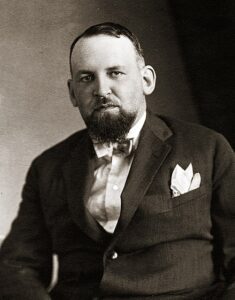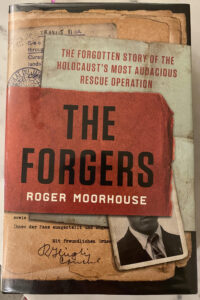
The Ładoś group executed one of the largest rescue operations of the Holocaust. Their story is one of moral bravery and great personal integrity. But who were they and why don’t we know more about them?
Aleksander Ładoś (1891 – 1963) served as the Polish envoy to Switzerland from 1940-1945. Under his direction, Polish diplomats began cooperating with Jewish communities in Switzerland. Its members began mass production of false passports and other documents to help save European Jews from the Holocaust. They issued more than 10,000 forged Latin American visas.
Holders of the visas never knew where they came from or the behind-the-scenes bravery of those who produced the life-saving documents.
 British historian Roger Moorhouse published a definitive book in 2023 on the subject.
British historian Roger Moorhouse published a definitive book in 2023 on the subject.
This book should be a mainstay of Holocaust literature and serve as a key reference for the Ładoś operation. It is well-written and thoroughly researched. Moorhouse is a historian specializing in modern German and Central European history, especially Nazi Germany and Poland during WW2.
It leans towards a scholarly work, as it includes a lot of background of the Holocaust and history. The background is necessary to establish the context, risk, and timing of their operation. Those with an interest will find it fascinating, and a fast read.
“The Ładoś Group was a group of men coming together, doing what they could, to assist those in dire need.” – Roger Moorhouse
Aleksander Ładoś, took inspiration from Chiune Sugihara of Japan
Aleksander took inspiration from Chiune Sugihara, the Japanese Consul who saved Jews in Kovno, Lithuania. Sugihara defied his superiors and issued more than 2,200 transit visas to Japan, primarily to escaping Polish Jews. (The story of Chiune Sugihara is another great story of World War II.) During the operation, Polish diplomats partnered with Sugihara to use Japanese diplomatic mail to transfer the “packages” as the passports were referred to communications. Polish diplomats also assisted escaping Jews who arrived in Japan.
“This is a humanitarian operation. We aim to save as many Jews as is possible.” – Aleksander Ładoś, during a Swiss interrogation
Six people comprised the Ładoś Group, all born in Poland
Aleksander’s friends and co-workers included his deputy Stefan Ryniewicz, consul Konstanty Rokicki. Juliusz Kühl, a Polish Jew, worked there as the information advisor on Jewish affairs. They worked closely with Abraham Silberschein, and Chaim Eiss of Jewish organizations. In an act of Polish-Jewish cooperation, the group consisted of three Poles, and three Polish Jews, working together on a common cause: save as many lives as possible.
An operation the size of the Ładoś required many people – no one person could have succeeded. It also took money. The passports were purchased from the Swiss consul, so funds were needed for the passports. Then there was the smuggling of photos of the intended recipients from inside the ghettoes to put on the visas.
The majority of passports were to Paraguay but also included Honduras, Haiti, and Peru. Latin American countries were key because they were non-occupied foreign countries far from the war and German law. The Germans separated those doomed to death camps, from who they believed were foreign citizens. The passports were no guarantee of survival, but they increased the odds. More than 3,200 survivors have been documented on “The Lados List”. Click here for the list of visas issued.
Why is there so little recognition of the Ładoś Group and its members?
First, the diplomats operated behind the scenes. Members did not leave diaries, papers, or any kind of historical record. They disappeared from public life after the war, especially under communist regimes.
Secondly, holders of the Latin American passports never knew where their documents came from. They only knew they came from Jewish aid organizations (who worked secretly with the Ładoś group.) Several Holocaust memoirs reference being saved with a Paraguayan, or Latin American passport.
Third, recognition by Yad Vashem as Righteous Among the Nations required the testimony of the survivors who were saved. If you didn’t know where your passport came from, how could anyone testify on behalf of the diplomats? Only Konstanty Rokicki was recognized by Yad Vashem in 2019. He was the one who filled in most of the passports, so his name was documented.
“Whoever saves a single life is considered by scripture to have saved the whole world.” – The Talmud (Sanhedrin 37a)
The United States Holocaust Memorial Museum holds a collection of papers of Julius Kühl. Click here.
The Ładoś Group was one of the largest diplomatic rescue operations during the Holocaust.
Some names may be more recognized such as:
- Raoul Gustaf Wallenberg of Sweden is estimated to have saved 4,500 individuals by issuing protective paperwork.
- Chiune Sugihara of Japan is estimated to have saved up to 6,000 through issuing transit visas.
- Aristides de Sousa Mendes of Portugal issued visas and passports for an undetermined number of refugees.
I mention these names to underscore the breadth of diplomats who used their positions to save as many Jews as possible. Comparative stories also underscore the size and magnitude of the Ładoś operation and how much they accomplished. The website Holocaust Rescue documented a full list of known diplomats who helped rescue Jews. Click here to read. Entire volumes, awards, and attention have been dedicated to several of these individuals like Wallenberg, Sugihara, and Sousa Mendes, while many others remain in relative obscurity or anonymity. Further, because the Ładoś Group included multiple individual individuals, it has to include more than the name of Aleksander Ładoś.
Each story gives us a role model for those who demonstrate moral integrity, at great personal risk, and for no recognition. I believe we need these stories now, more than ever.
For more information, including a list of visas issued and whether their holders survived, visit
International Committee of the Ładoś Group, https://theladosgroup.com/
Documentary on the operation on YouTube: Click here.

1 Comment. Leave new
Thanks very much for making this and similar groups known to the public. They are great correctives to negative stereotypes of Polish-Jewish relations that still persist. I recall years ago in Jr. High School when one self-presumed “intellectual” declared “Poles hate Jews” and contended that they handed over Jews in concentration camps to the Germans and even pushed them into gas chambers. I thought it shocking at the time, and now see clearly how such statements are also stupid and ignorant.